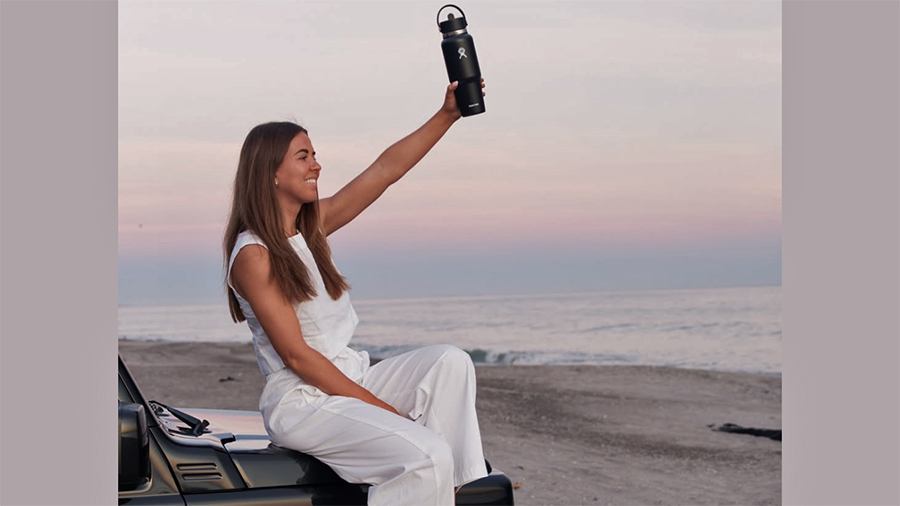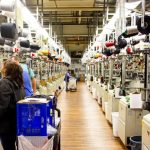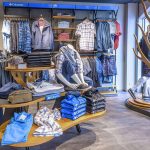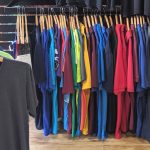Helen of Troy, Ltd. reported sales in its Home & Outdoor segment, which includes Hydro Flask, Osprey and Oxo, declined 10.3 percent in the fiscal first quarter ended May 31 due in part to weaker demand for insulated beverageware and the cancellation of orders due to tariffs. Sales are expected to decline in the range of 16.5 percent to 11.5 percent in the fiscal second quarter.
Sales in the Home & Outdoor segment in the first quarter decreased $20.5 million to $178.0 million, compared to $198.5 million. Helen of Troy said the decrease was primarily driven by:
- softer consumer demand in the home and insulated beverageware categories resulting in lower replenishment orders;
- cancellation of direct import orders in response to higher tariffs;
- retailer pull-forward activity in the fourth quarter of fiscal 2025 due to tariff uncertainty and potential supply disruption resulting in higher retail inventory and lower replenishment;
- lower closeout channel sales; and
- a net decrease in distribution year-over-year.
These factors were partially offset by strong domestic demand for technical packs and the favorable comparative impact of shipping disruption at the company’s Tennessee distribution facility due to automation startup issues during the same period last year.
Home & Outdoor’s operating loss was $213.8 million, or (120.1) percent of segment net sales revenue, compared to operating income of $15.9 million, or 8.0 percent of segment net sales revenue. The operating loss in the first quarter of fiscal 2026 included $219.1 million of pre-tax asset impairment charges and $1.7 million of CEO succession costs. The remaining 400 basis point decrease in segment operating margin was primarily due to the comparative impact of favorable inventory obsolescence expense in the prior year, a less favorable brand mix, consumer trade-down behavior, higher outbound freight costs, higher marketing expense, higher retail trade expense, and the impact of unfavorable operating leverage. These factors were partially offset by lower commodity and product costs. Adjusted operating income decreased 57.9 percent to $8.9 million, or 5.0 percent of segment net sales revenue, compared to $21.1 million, or 10.6 percent of segment net sales revenue.
Consolidated Results | First Quarter Fiscal 2026 Compared to First Quarter Fiscal 2025
- Consolidated net sales revenue decreased $45.2 million, or 10.8 percent, to $371.7 million, compared to $416.8 million, driven by a decrease from Organic business of $71.0 million, or 17.0 percent. The Organic business decrease was due to a decline in Beauty & Wellness primarily driven by lower sales of thermometers, fans, and hair appliances and a decline in Home & Outdoor primarily resulting from a decrease in home and insulated beverageware sales. The Organic business decline was partially offset by the contribution from the acquisition of Olive & June, LLC of $26.8 million, or 6.4 percent, to consolidated net sales revenue and strong domestic demand for technical packs in Home & Outdoor.
- Consolidated gross profit margin decreased 160 basis points to 47.1 percent, compared to 48.7 percent. The decrease in consolidated gross profit margin was primarily due to the comparative impact of favorable inventory obsolescence expense in the prior year, consumer trade-down behavior, higher retail trade expense and a less favorable brand mix within Home & Outdoor. These factors were partially offset by the favorable impact of the acquisition of Olive & June within Beauty & Wellness and lower commodity and product costs, partly driven by Project Pegasus initiatives.
- Consolidated selling, general and administrative expense (SG&A) ratio increased 420 basis points to 45.1 percent, compared to 40.9 percent. The increase in the consolidated SG&A ratio was primarily due to higher marketing expense, higher outbound freight costs, CEO succession costs of $3.5 million, the impact of the Olive & June acquisition and the impact of unfavorable operating leverage due to the decrease in net sales.
- The company recognized non-cash asset impairment charges of $414.4 million ($436.2 million after tax), during the first quarter of fiscal 2026, to reduce goodwill by $317.0 million and other intangible assets by $97.4 million, which impacted both the Beauty & Wellness and Home & Outdoor segments.
- Consolidated operating loss was $407.0 million, or (109.5) percent of net sales revenue, compared to consolidated operating income of $30.8 million, or 7.4 percent of net sales revenue. The decrease in consolidated operating margin was primarily due to non-cash asset impairment charges of $414.4 million, an increase in the aforementioned consolidated SG&A ratio and a decrease in consolidated gross profit margin.
- Interest expense was $13.8 million, compared to $12.5 million. The increase in interest expense was primarily due to higher average borrowings outstanding to fund the acquisition of Olive & June, increased inventory due to forward buys in advance of tariffs, and borrowings to fund higher tariff costs, partially offset by a lower average effective interest rate compared to the same period last year.
- Income tax expense was $30.2 million compared to $12.1 million, primarily due to the timing of the accounting for the tax impact of the impairment charge in the quarter and a related valuation allowance on intangible asset deferred tax assets, partially offset by a decrease in tax expense for discrete items.
- Net loss was $450.7 million, compared to net income of $6.2 million. Diluted loss per share was $19.65, compared to diluted earnings per share of 26 cents. The decrease is primarily due to the recognition of an after-tax asset impairment charge of $436.2 million during the first quarter of fiscal 2026 and lower operating income exclusive of the asset impairment charges.
- Non-GAAP adjusted EBITDA (earnings before interest, taxes, depreciation and amortization) was $25.5 million, compared to $52.4 million. Non-GAAP adjusted EBITDA margin was 6.9 percent compared to 12.6 percent.
On an adjusted basis (non-GAAP) for the first quarters of fiscal 2026 and 2025, excluding asset impairment charges, the discrete impact of Barbados tax reform, CEO succession costs, intangible asset reorganization, restructuring charges, amortization of intangible assets, and non-cash share-based compensation, as applicable:
- Adjusted operating income decreased $26.8 million, or 62.5 percent, to $16.1 million, or 4.3 percent of net sales revenue, compared to $43.0 million, or 10.3 percent of net sales revenue. The decrease in adjusted operating margin was primarily driven by the comparative impact of favorable inventory obsolescence expense in the prior year, higher marketing expense, consumer trade-down behavior, higher outbound freight costs, higher retail trade expense, a less favorable brand mix within Home & Outdoor and the impact of unfavorable operating leverage. These factors were partially offset by the favorable impact of the acquisition of Olive & June within Beauty & Wellness and lower commodity and product costs, partly driven by Project Pegasus initiatives.
- Adjusted income decreased $13.9 million, or 59.4 percent, to $9.5 million, compared to $23.3 million. Adjusted diluted earnings per share decreased 58.6 percent to $0.41, compared to $0.99. The decrease in adjusted diluted earnings per share was primarily due to lower adjusted operating income and higher interest expense, partially offset by a decrease in adjusted income tax expense.
Management Commentary
Timothy F. Meeker, chairman of the Board of Directors, stated: “The Board’s process to identify our next CEO is well underway with the support of a leading global executive search firm and we are encouraged by the progress thus far. We continue to prioritize selecting a CEO who has demonstrated success in leading a highly diversified global organization, has the ability to bolster our brands and inspire top talent to capitalize on Helen of Troy’s growth opportunities, and who closely aligns with our strong belief that Helen of Troy has tremendous potential. As we continue our search, we have confidence in our interim CEO Brian Grass, his dedication to Helen of Troy, and his commitment to improving our company’s performance.”
Brian L. Grass, interim chief executive officer, stated: “I feel fortunate to have stepped into my role as interim CEO with a strong understanding of our business, our opportunities, and the headwinds we face. I have spent considerable time listening closely to our stakeholders, especially our associates who care deeply about our brands, our purpose, and each other. It is clear that we have to get back to fundamentals and move with greater speed. We are focused on improving our go-to-market effectiveness, simplifying how we operate, refocusing on innovation for more product-driven growth, sharpening our spend, and reinvigorating our culture with resilience and an owner’s mindset.”
Grass continued: “The first quarter was challenging, with tariff-related impacts making up approximately 8 percentage points of the 10.8 percent consolidated revenue decline. That said, we are encouraged by underlying business improvements we saw in the quarter including U.S. point-of-sale unit growth in 8 out of our 11 key brands, growth in our DTC business, Osprey, and Curlsmith, and contribution from Olive & June ahead of our expectations. I am also pleased with the progress we are making to mitigate the impact of tariffs, and we now believe we can reduce our fiscal 2026 net tariff impact on operating income to less than $15 million based on tariffs currently in place. I want to thank our entire organization for their dedication and commitment to Helen of Troy’s success. I remain optimistic about our future as we create a stronger, healthier, and more agile company.”
Beauty & Wellness Segment Results
Beauty & Wellness net sales revenue decreased $24.7 million, or 11.3 percent, to $193.7 million, compared to $218.4 million. The decrease was primarily driven by a decrease from Organic business of $50.3 million, or 23.0 percent, primarily due to:
- a decline in international thermometry due to evolving dynamics in the China market, including a shift away from cross-border ecommerce toward localized fulfillment models, heightened competition from domestic sellers benefiting from government subsidies and a weaker illness season in Asia;
- a decrease in fan sales primarily driven by reduced replenishment orders from retail customers due to a decline in consumer demand and the cancellation of direct import orders from China in response to higher tariffs; and
- a decline in sales of hair appliances and prestige hair care products primarily due to softer consumer demand, increased competition, and a net decrease in distribution year-over-year.
These factors were partially offset by the favorable comparative impact of the shipping disruption from Curlsmith system integration challenges during the same period last year and higher sales of heaters.
The Organic business decline was also partially offset by the contribution from the acquisition of Olive & June of $26.8 million, or 12.3 percent, to segment net sales revenue.
Beauty & Wellness operating loss was $193.2 million, or (99.8) percent of segment net sales revenue, compared to operating income of $14.9 million, or 6.8 percent of segment net sales revenue. Operating loss in the first quarter of fiscal 2026 included $195.3 million of pre-tax impairment charges and $1.7 million of CEO succession costs. The remaining 480 basis point decrease in segment operating margin was primarily due to higher marketing expense, the comparative impact of favorable inventory obsolescence expense in the prior year, consumer trade-down behavior, higher outbound freight costs, higher retail trade expense, and the impact of unfavorable operating leverage. These factors were partially offset by the favorable impact of the acquisition of Olive & June, favorable product liability expense and lower commodity and product costs. Adjusted operating income decreased 66.8 percent to $7.3 million, or 3.7 percent of segment net sales revenue, compared to $21.9 million, or 10.0 percent of segment net sales revenue.
Balance Sheet and Cash Flow | First Quarter Fiscal 2026 Compared to First Quarter Fiscal 2025
- Cash and cash equivalents totaled $22.7 million, compared to $16.1 million.
- Accounts receivable turnover was 69.7 days, compared to 67.4 days.
- Inventory was $484.1 million, compared to $444.7 million.
- Total short- and long-term debt was $871.0 million, compared to $748.4 million.
- Net cash provided by operating activities for the first three months of the fiscal year was $58.3 million, compared to $25.3 million for the same period last year.
- Free cash flow for the first three months of the fiscal year was $45.0 million, compared to $16.2 million for the same period last year.
Second Quarter Fiscal 2026 Outlook
Helen of Troy said that due to evolving global tariff policies and the related business and macroeconomic uncertainty, the company is only providing an outlook for the second quarter of fiscal 2026 at this time. The company said it is continuing to assess the incremental tariff cost exposure in light of continuing changes to global tariff policies and the full extent of its potential mitigation plans, as well as the associated timing to implement such plans. The company is also continuing to assess the disruptive impact that tariffs are having on the company’s markets and retailer adaptation to tariff costs and uncertainty. To mitigate the company’s risk of ongoing exposure to tariffs, it has initiated significant efforts to diversify its production outside of China into regions where it expects tariffs or overall costs to be lower and to source the same product in more than one region, to the extent it is possible and not cost-prohibitive. The company now expects to reduce its cost of goods sold exposed to China tariffs to less than 25 percent by the end of fiscal 2026. The company is also continuing to implement other mitigation actions, which include cost reductions from suppliers and price increases to customers on products subject to tariffs. In addition to the uncertainty from evolving global tariff policies, the company expects unfavorable cascading impacts on inflation, consumer confidence, employment, and overall macroeconomic conditions, all of which are impossible to predict at this time and outside of the company’s control.
The company adjusted its measures to reduce costs and preserve cash flow, outlined in its fourth quarter fiscal 2025 earnings release, as the environment continued to evolve. While the company has resumed targeted growth investments, the company remains disciplined in its approach given continued tariff volatility. The current measures in place include the following:
- Suspension of projects and capital expenditures that are not critical or in support of supplier diversification or dual sourcing initiatives;
- Actions to reduce overall personnel costs and pause most project and travel expenses remain in place;
- A resumption of optimized marketing, promotional, and new product development investments focused on opportunities with the highest returns;
- A resumption of targeted inventory purchases from China in the short term, with a measured approach in expectation of softer consumer demand in the short to intermediate term; and
- Actions to optimize working capital and balance sheet productivity.
Through the combination of tariff mitigation actions and these additional cost reduction measures, the company now believes it can reduce the net tariff impact on operating income to less than $15 million, based on tariffs currently in place.
The company expects consolidated net sales revenue in the range of $408 million to $432 million, which implies a decline of 14.0 percent to 8.9 percent, compared to the second quarter of fiscal 2025. The consolidated net sales outlook reflects the following expectations by segment:
- Home & Outdoor net sales decline of 16.5 percent to 11.5 percent, compared to the second quarter of fiscal 2025; and
- Beauty & Wellness net sales decline of 11.3 percent to 6.1 percent, compared to the second quarter of fiscal 2025, which includes an expected incremental net sales contribution of $26 million to $27 million from the Olive & June acquisition.
The sales outlook reflects the company’s view of continued consumer spending softness, especially in certain discretionary categories, as well as its view of increased macro uncertainty, a more promotional environment, and an increasingly stretched consumer, including the impact from:
- the pause or cancellation of direct import orders in response to higher tariffs;
- ongoing impact from the shift from cross border ecommerce to localized distribution and sustained competitive pressure from government-subsidized domestic sellers in China;
- continued softer consumer demand and increased competition;
- ongoing consumer trade-down behavior as shoppers seek greater value and prioritize essential categories; and
- retailer inventory rebalancing in response to demand trends.
The company expects GAAP diluted earnings per share of $0.56 to $0.68 and non-GAAP adjusted diluted EPS in the range of 45 cents to 60 cents, which implies an adjusted diluted EPS decline of 62.8 percent to 50.4 percent, compared to the second quarter of fiscal 2025. The company’s outlook also reflects:
- the impact of a more promotional environment, consumer trade-down behavior, and a less favorable mix;
- higher commodity and product costs driven by direct tariff-related costs offset by Project Pegasus initiatives;
- the comparative impact of unfavorable operating efficiencies related to automation startup of the Tennessee distribution facility in the prior year; and
- the impact of unfavorable operating leverage due to the decline in revenue.
The company continues to expect these factors to be partially offset by cost reduction measures implemented in the first quarter and continuing throughout the year.
The company’s second quarter fiscal 2026 consolidated net sales and EPS outlook also reflects the following assumptions:
- June 2025 foreign currency exchange rates will remain constant;
- expected interest expense in the range of $13 million to $14 million;
- a reported GAAP effective tax rate range of (84.9) percent to (287.3) percent and an adjusted effective tax rate range of 28.9 percent to 30.9 percent; and
- an estimated weighted average diluted shares outstanding of 22.9 million.
The likelihood, timing and potential impact of a significant or prolonged recession, any fiscal 2026 acquisitions and divestitures, future asset impairment charges, future foreign currency fluctuations, additional interest rate changes, or share repurchases are unknown and cannot be reasonably estimated; therefore, they are not included in the company’s outlook.
Image courtesy Hydro Flask
















